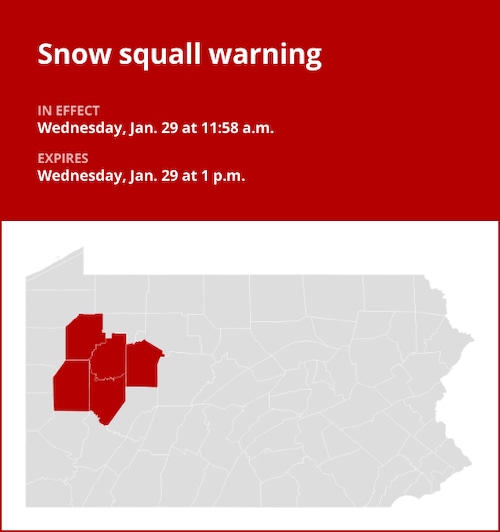The National Weather Service issued an updated snow squall warning for Armstrong, Butler, Clarion, Jefferson, and Venango counties on Wednesday at 11:58 a.m., which was in force until 1 p.m.
“At 11:58 a.m., a dangerous snow squall was located along a line extending from near Penfield to 9 miles southwest of Franklin, moving southeast at 15 mph,” according to the meteorological service. “This includes Interstate 80 in Pennsylvania between mile markers 28 and 96.”
Brookville, Knox, Reynoldsville, Brockway, Sykesville, Falls Creek, Parker, Sligo, Emlenton, Strattanville, Summerville, Clintonville, Limestone, Shippenville, St. Petersburg, Corsica, Eau Claire, Kennerdell, and Barkeyville are among the places affected by the warning.
“Travel will become difficult and potentially dangerous within minutes,” the weather agency announces. “If you are on a highway, locate the closest exit or rest area and park securely out of traffic’s way. Before attempting to restart travel, wait for snow squalls to pass. When a snowstorm hits a highway, there is nowhere safe to go. In whiteout situations, visibility and traction are instantly compromised, making it difficult or impossible to reduce speed and avoid stopped cars. Before the snow squall hits, postpone your trip or get off the roadway safely.
Strong bursts of heavy snow are one of the hazards. gusty winds that cause snow to blow and visibility to drop quickly. gusts of up to 35 miles per hour.
Snow squalls: Safety protocols and prevention tips
What are snow squalls?
Strong cold fronts are frequently linked to snow squalls, which are severe winter weather conditions. Even in the absence of a significant winter storm, they can swiftly cover roads with snow and ice. Even while these squalls usually last less than an hour and only produce light snow accumulation, their restricted visibility, strong winds, and quickly falling temperatures can make them dangerous. Unfortunately, in the past, these circumstances have played a role in catastrophic and occasionally fatal road accidents.
What is the difference between a snow squall and a snowstorm?
The length of the event distinguishes a snowstorm from a snow squall. Typically lasting between 30 and 60 minutes, snow squalls are incredibly powerful. Days or even hours may pass during a snowfall.
Snow squall warnings
Like warnings for tornadoes or severe thunderstorms, snow squalls are quickly issued for specific locations. They provide vital, locally relevant information that can save lives. If there is a snow squall warning in your location, it is recommended to wait until the squall passes before driving.
Actions to take
When a snow squall warning is issued, people should heed the weather service’s instructions, which include the following crucial steps:
Avoid or postpone travel: It is best to wait until the snow squall has gone through your area before driving if a snow squall warning has been issued for your area. During snow squalls, roadways and highways are especially dangerous.
Reduce speed and improve visibility: If you’re already on the road during a snowstorm, put safety first by slowing down. To improve visibility for other vehicles and yourself, turn on your danger lights in addition to your headlights.
Keep a safe distance by giving the automobile in front of you plenty of space.
Steer clear of sudden braking: It’s also best to avoid applying the brakes too hard. This could lead to a loss of vehicle control and raise the possibility of a chain reaction collision on slick or icy roads.
Winter weather safety advice: Check out the weather service’s Winter Weather Safety page for advice on how to keep safe before, during, and after winter weather.
Get your car ready:Make sure your car is winter-ready before you hit the road this winter by checking the tires, brakes, lights, and making sure all the fluids are at the right levels. A well-maintained car can handle the rigors of winter roads more easily.
Important supplies for your car’s emergency kit: Make sure your car has a complete emergency kit that includes necessities like blankets, water, non-perishable food, a flashlight, and a first aid kit. To improve tire traction, don’t forget to have jumper cables, flares or a reflective triangle, ice scraper, a map, a car cell phone charger, and cat litter or sand. In the event of an emergency or unplanned breakdown while traveling, these provisions may prove to be quite beneficial.
In conclusion, putting one’s own safety first and following the weather service’s advice can greatly reduce dangers when a snow squall warning is in effect. People can travel through these winter dangers with more assurance and security if they are aware of them, plan beforehand, and remain alert.
United Robots offers a service called Advance Local Weather Alerts that gathers the most recent information from the National Weather Service using machine learning.

